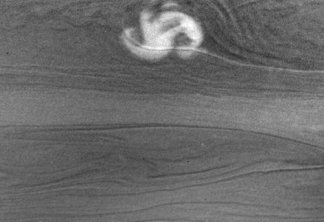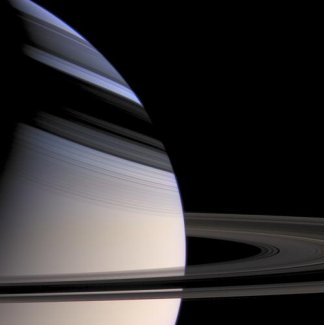Storm on Saturn
A spacecraft photographed the most powerful storm ever seen on Saturn.
Share this:
- Share via email (Opens in new window) Email
- Click to share on Facebook (Opens in new window) Facebook
- Click to share on X (Opens in new window) X
- Click to share on Pinterest (Opens in new window) Pinterest
- Click to share on Reddit (Opens in new window) Reddit
- Share to Google Classroom (Opens in new window) Google Classroom
- Click to print (Opens in new window) Print
By Emily Sohn
Saturn is a stormy place, and a spacecraft recently photographed the most powerful squall ever seen on the ringed planet.
 |
|
This image, taken by the Saturn-orbiting Cassini spacecraft on Jan. 27, shows a rare and powerful storm (white swirl near top) on the planet’s night side.
|
| NASA/JPL/Space Science Institute |
The spacecraft, called Cassini, has been orbiting and inspecting Saturn since July 2004. The first signs of this storm were captured by Cassini on Jan. 23, when lightning deep within the planet’s atmosphere caused radio noise that was picked up by the craft.
The storm was one of many that have been observed in Storm Alley, a region in Saturn’s southern hemisphere. Most of the planet’s storms occur beneath the clouds, so astronomers can detect only the strongest events.
This one measured 3,500 kilometers (2,175 miles) from north to south. That’s about the distance between Salt Lake City and New York. The storm occurred on the planet’s dark side, so Cassini had to use light reflected by the planet’s icy rings to get images of the storm.
 |
|
The tiny amount of light reflected by Saturn’s icy rings allowed a massive storm on the night side of the planet to be photographed by Cassini.
|
| NASA/JPL/Space Science Institute |
Using small telescopes on Earth, amateur astronomers were later able to get the first pictures using visible light.
It feels good to be warm and dry, doesn’t it?—E. Sohn
Going Deeper:
Cowen, Ron. 2006. Eyeing a Saturn storm. Science News 169(Feb. 25):118. Available at http://www.sciencenews.org/articles/20060225/fob8.asp .
You can get additional information about Cassini and the storm on Saturn at www.nasa.gov/mission_pages/cassini/multimedia/pia07789.html (NASA) and ciclops.org/view.php?id=1838 or www.eurekalert.org/pub_releases/2006-02/ssi-ccs021406.php (Space Science Institute).
Sohn, Emily. 2004. Ringing Saturn. Science News for Kids (July 28). Available at http://sciencenewsforkids.org/articles/20040728/Feature1.asp .







